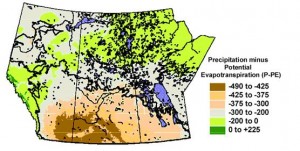 On this page we deal with two aspects of agricultural adaptation in Manitoba
On this page we deal with two aspects of agricultural adaptation in Manitoba
- Key issues
- Moisture
- Insects, weeds, & disease
- Key strategies to deal with the issues
Click a link in the list above to jump to that topic on this page.
Predicted increases in temperature will likely lengthen the growing season (which is a good thing) and increased crop production may be possible in northern regions where suitable soils exist. However, higher temperatures and lower soil moisture may ultimately have a negative effect on dryland agriculture.
Key issues
Moisture
It is moisture that could be the limiting factor for agricultural production on the prairies. Most climate change scenarios suggest that the semi-arid regions of the Prairies can expect an increase in the frequency of drought (1). This means that southwestern Manitoba may become drier overall.
Many computer climate models predict average annual precipitation to increase slightly in the arable regions of Manitoba. However, this gain is offset by higher temperatures that increase evaporation – thus increasing moisture deficits.
The moisture deficit area projected for the middle of this century extends over most of the cultivated land in Southern Manitoba and is worst in the southwest corner of the province (2).
Figure 1 shows the projected moisture deficit for the Prairie Provinces in the decades 2040-2069. This map is drawn by the Canadian General Circulation Model scenario CGCM1.
Notice that Manitoba may become less dry in the northeast.
Insects, weeds, & disease
The extra heat could also increase the potential risk of insect, weed, and disease infestation, because warmer temperatures allow pests to thrive, rather than die-off in the cold (3).
Key strategies
We need to build the adaptive capacity of rural areas. This strategy will require some government policy changes and some changes that producers can bring about on their own.
Enhancement areas to be considered include (4):
- maintaining and promoting sustainable soil management practices
- discouraging farming on marginal land
- investing in farm machinery and equipment versatile enough to adjust production decisions to variable climatic conditions
- providing access to irrigation and associated equipment
- creating more opportunities to increase off-farm earnings
- enhancing employment prospects through diversification within agricultural and other sectors of the economy
- providing climate-friendly transportation choices for rural goods and people
- improving access to and use of computer technology especially for farm management
- improving the use of e-mail and Internet access in rural areas to keep abreast of climate trends and innovative farming practices
- providing greater access to agricultural education institutions





